
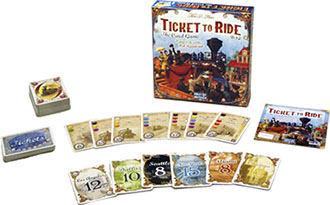
Components
- 96 Train cards
- 6 Big Cities Bonus cards
- 46 Destination Ticket cards
- Instructions
Object of the Game
The object of the game is to score the highest total number of points. Players score points by completing the Destination Tickets in their hands.
They also score points by winning Big Cities Bonus cards at the game's end. But beware - points are lost for any uncompleted Destination Tickets, at this stage!
Setup

Give each player 1 Locomotive card (wild card) 1.
Shuffle the rest of the Train cards into a Train deck, including any Locomotives left over; deal 7 cards to each player 2 and place the rest of the Train deck within easy reach of all players.
Draw the top 5 cards from the deck and place them face-up, in a row, in the Draw area next to the Train deck 3. Place the 6 Big Cities Bonus cards off to the side, their value visible to all players 4.
Now, shuffle the Destination Tickets and deal 6 to each player 5. Place the remaining Tickets face down in a Ticket deck 6.
Each player now looks at his Tickets in secret and chooses which ones he wishes to keep. Each player must keep at least 1 Destination Ticket, but may keep as many as all 6 if he wishes to. Unwanted Tickets are shuffled back into the Ticket deck.
You are now ready to begin.
Duration of the Game
Two or three-player games go through the deck of Train cards once. When the Train deck is depleted, there is a final turn of play; the game ends, and points are scored.
In a four-player game, when the deck runs out, it triggers the first scoring of completed Destination Tickets; the discard pile of Train cards is then reshuffled into a new Train deck, and it is only when this second Train deck runs out that the game ends and the final score is computed.
Game Play
During the course of the game, players will have the opportunity to:
Draw new Destination Tickets or new Train cards into their hand;
Place Train cards from their hands into an area in front of them called their Railyard;
Move Train cards out of their Railyard and into a single On-The-Track stack of Train cards, face down, in front of them.
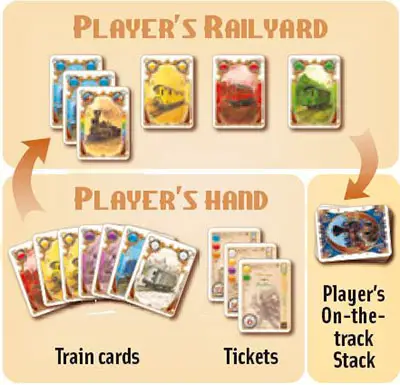
Players will use Train cards in their On-the- Track stack to match the quantity and colors of routes on their Destination Tickets, scoring points for completed Tickets and possibly winning Big Cities bonuses in the process.
The youngest player goes first. Play then proceeds clockwise around the table, each player taking 1 turn at a time.
A player's turn consists of 2 separate steps:
Step 1
Move Train Cards out of his Railyard and On- the-Track - If a player has any Train cards in his Railyard, he must take 1 card from each colored row of Train cards in his Railyard and place these cards face down, in a single, separate stack: his On-the-Track stack.
Once cards are placed in a player's On-the- Track stack, they must remain there, hidden from all players including himself, until the Train deck runs out and it is time to score Tickets.
Note: When playing with inexperienced or younger players, you may wish to let every- one look through their own On-the-Track stack at any time.
On the player's first turn, or when the player has no cards in his Railyard, this step is skipped.
Step 2
The Player must now perform one (and only one) of the following three actions:
- Draw some new Train Cards; or
- Place Train Cards in his Railyard; or
- Draw Destination Tickets
A. Draw Some New Train Cards
(Same rules as for drawing Train cards in the Ticket to Ride boardgame, except that the appearance of a 3rd Locomotive face-up does not trigger a flush of the face-up cards).
The player draws up to 2 Train cards from the top of the Train deck and/or from any of the 5 face-up Train cards laid out next to it in the Draw area. Cards drawn face-up are immediately replaced, by revealing a new card from the Train deck and placing it in its place, before any other card is picked up.
Locomotives drawn face-up count as a 2 card pick; the player's turn ends immediately thereafter. Locomotives drawn blindly from the top of the Train deck count as regular (single) picks, however.
There is no limit to the number of cards a player may have in hand at any time, so this option is always available unless there are no Train cards left to draw.
OR
B. Place Train Cards in His Railyard
The player plays from his hand, and places face-up in his Railyard:
- A suit of 2 or more Train cards of the same color; or
- Exactly 3 cards, each of a different color.
When playing a suit of 2 or more cards of the same color, the cards must be placed in a single row in the player's Railyard, each slightly offset from the card just under it.
Locomotives may be played as part of that suit, but must all be placed on top of the row. When Locomotives are later used to complete Destination Tickets, they can be used as any color, not just the color of the suit in which they were played when first placed into the Railyard.
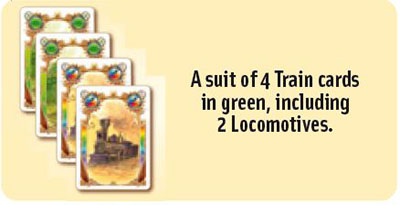
When playing Train cards of different colors, exactly 3 cards must be played, each of a different color; and Locomotives can never be played as part of that mix.
Train cards whose color is already present in the player's Railyard can never be played, until the original cards in that color are removed from the player's Railyard.
In addition, Train cards whose color is already present in another opponent's Railyard can- not be played, unless more of them are played than exists in the opponent's Railyard. If the player does play more, his opponent must immediately discard all his original cards of that color from his Railyard. This is called "Train robbing".
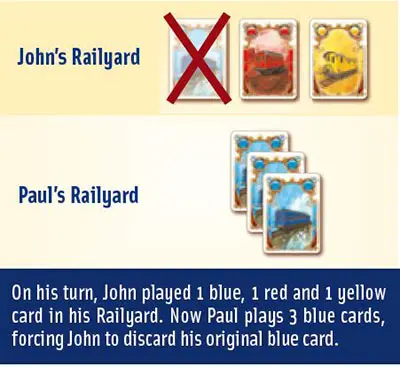
OR
C. Draw Destination Tickets
The player draws 4 new Destination Tickets from the top of the Ticket deck. He can keep any number of them, including none. Unwanted Tickets are placed back to the bottom of the Ticket deck.
Once a player is done with his turn, play proceeds to the next player clockwise, until there are no Train cards left in the Train deck.
When the Train Deck Runs Out..
When the last card is drawn from the Train deck, each player gets 1 more turn, including the player who drew the last card from the deck. If there is only 1 Train card left to pick up, a player may decide to use his turn to draw this single card.
Other players must then choose one of the other options left to them (Draw Tickets or Place Train cards in their Railyard), during their own Step 2.
Players now use the Train cards in their own On-the-Track stack to complete as many of their Destination Tickets as possible. Each ticket displays the number of cards of each color required to complete the Ticket. Each card can only be used to complete 1 Destination Ticket.
Locomotives can replace any color. To complete a Destination Ticket, a player must match, from his On-the-Track stack, a set of Train cards of the same colors and quantity as the routes listed on his Ticket.
Locomotives are wild cards and can be used for any color. Color-blind players may use the symbol shapes displayed in the extreme upper corners of the Train cards and on the right-hand side of each Ticket to distinguish between colors.
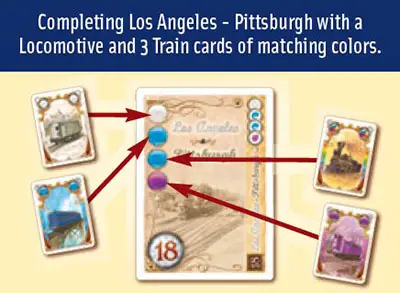
Once verifications are made that all Tickets claimed were indeed successfully completed, each player's completed Ticket values are added up; and the completed Tickets are set aside, face down, next to each player.
If there are 2 or 3 players, the game is over (go to Game End and Calculating Scores).
Four-player Game
If there are 4 players, the game continues instead, as follows:
Any Destination Tickets that were not completed remain secret and stay in the players' hands. The Train cards that were not played and are still in a player's hand remain there as well.
All other Train cards, including those used for just-completed Tickets, and any unused cards left in the players' On-the-Track stack or Railyard, are discarded. The discards are thoroughly reshuffled and form a new Train deck.
Deal each player 4 Train cards from the newly reshuffled Train deck. Each player adds these cards to his hand.
Play then resumes exactly as before, begin- ning with the player to the left of the player who took the last turn, until the Train deck runs out again. Score points for the newly completed Destination Tickets, and add these to the players' prior scores.
End of the Game
Players with uncompleted Destination Tickets still in their hand must now subtract these Ticket values from their score.

In addition, the player with the most completed Destination Tickets to each of the Big Cities, (Seattle, Los Angeles, Chicago, Dallas, New York, and Miami) receives the Bonus card for that city and adds the points on that Bonus card to his score.
In the event of a tie, all tied players score the bonus points. Destination Tickets with 2 big cities listed on them count toward the bonus for both cities.
The player with the most points wins the game. If two or more players are tied for the most points, the player who has completed the most Tickets wins. In the unlikely event, they are still tied, the player with the most bonus cards wins.
Other Ticket to Ride Games
Continue Reading


